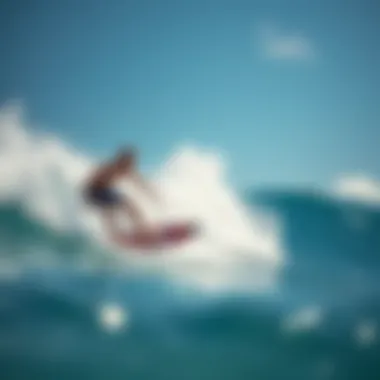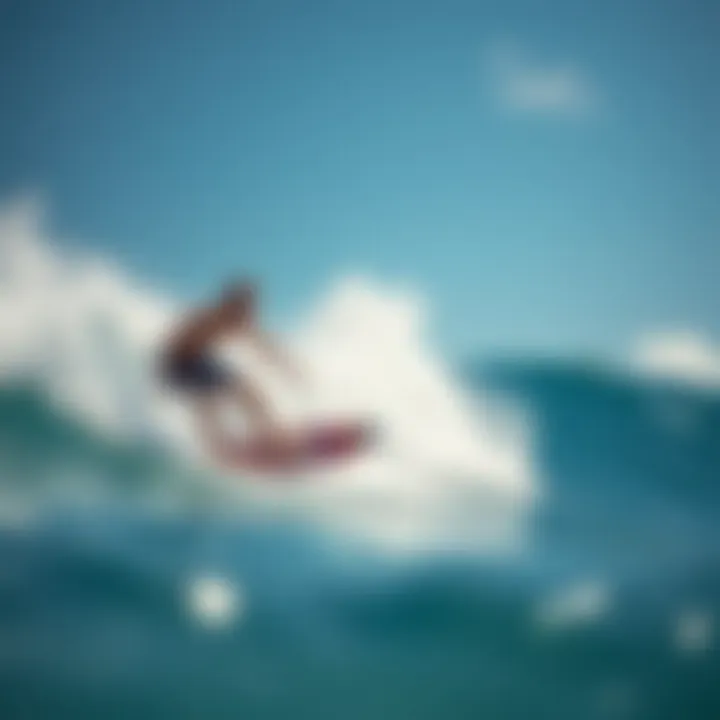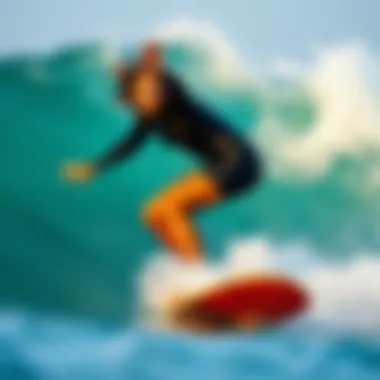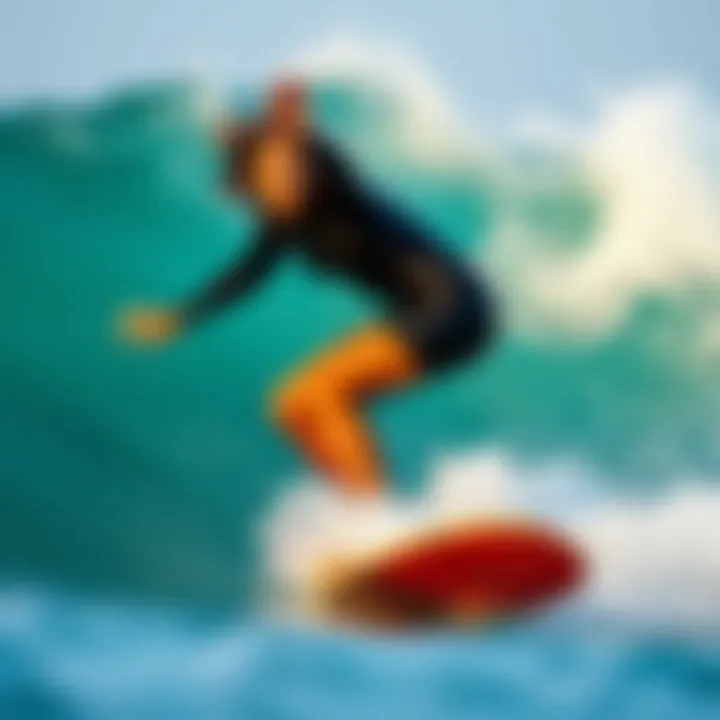Mastering the Art of Boogie Board Surfing Techniques


Intro
Boogie board surfing, often seen as the underdog of wave riding, holds a unique allure that captivates enthusiasts of all ages. Unlike traditional surfing, which might seem daunting to newcomers, boogie boarding offers a more accessible entry point into the world of ocean sports. This article will explore the ins and outs of boogie board surfing, catering to both novices eager to dive into the waves and seasoned riders looking to refine their skills.
Understanding the dynamics of this sport goes far beyond just catching a wave. It encompasses learning the critical techniques that allow riders to navigate the surf confidently, selecting the appropriate equipment that suits one’s personal style, and appreciating the cultural aspects that shape the boogie boarding community. With every twist and turn of a wave, the experience can be transformative, fostering a deep connection between the rider and the ocean.
In the following sections, we will delve into essential techniques for various skill levels, guidance on selecting and maintaining your boogie board, and an exploration of boogie boarding’s impact on personal well-being and societal perceptions. Let’s carve our way into the art of boogie board surfing.
Foreword to Boogie Boarding
Boogie boarding, often simply referred to as bodyboarding, represents a unique fusion of thrill and art within the realm of water sports. For many enthusiasts, it’s more than just a recreational activity; it serves as a gateway to the ocean, providing both an adrenaline rush and a rich sense of connection to nature. Understanding the foundation of this engaging sport not only enhances one’s appreciation for the craft but also aids in mastering the diverse skills involved.
The Importance of Boogie Boarding
In this article, we aim to peel back the layers of what makes boogie boarding a cherished pastime. From the basics of board selection to advanced techniques, the comprehensive exploration is tailored for all, regardless of experience level. Additionally, acknowledging crucial elements—including safety, choice of equipment, and cultural significance—ensures that participants approach the water with respect and knowledge.
Embarking on the journey of boogie boarding can be a fulfilling pursuit, offering countless benefits:
- Physical Fitness: Engaging in this sport promotes muscle tone and cardiovascular health.
- Mental Well-Being: The act of riding waves often leads to a meditative state, releasing stress and encouraging mindfulness.
- Community Connection: Boogie boarding fosters bonds among enthusiasts who share a passion for the waves.
History and Evolution
The history of boogie boarding traces back to the 1970s on the Hawaiian islands, where the sport was popularized by figures like Tom Morey. He introduced the first boogie board, which allowed riders to harness the power of ocean waves in a unique way. It takes inspiration from older forms of wave riding, yet it broke away to create its own identity, blending fun with technical prowess.
Over the years, the evolution of boogie boarding has seen innovations in board designs, including different materials and shapes tailored for specific conditions and rider preferences. This adaptation reflects not just the technological advancements in surf culture, but also the growing diversity of riders participating in the sport.
Cultural Impact
Culturally, boogie boarding has carved a niche for itself in coastal communities around the world. It encourages a profound respect for ocean environments and has become a platform for social interaction and cultural exchange. Local competitions and events often celebrate not just skill but also creativity among athletes.
Moreover, it acts as a bridge that connects people from various backgrounds, introducing the core values of camaraderie, sharing knowledge, and a respect for nature. Through boogie boarding, individuals can participate in a larger community that values fun, adventure, and a commitment to preserving beach environments.
From the shores of California to the beaches of Australia, the cultural significance of boogie boarding continues to grow, fostering a vibrant and inclusive atmosphere for both seasoned surfers and newcomers alike.
Understanding Boogie Board Dynamics
Understanding the dynamics of boogie board surfing is crucial not just for those who are just starting out but also for seasoned riders. This knowledge influences every aspect of your surfing experience—your performance, enjoyment, and safety in the water. A clear comprehension of how waves interact with your board and the materials used in board construction can enhance your skills significantly.
Engaging fully with the dynamics means taking into account the physics behind how waves break, the environment surrounding these breaks, and how different designs impact your riding ability. An in-depth grasp of these elements can lead to better control and greater enjoyment on the wave. Here’s a closer look at two key dimensions of boogie board dynamics:
Wave Types and Characteristics
When it comes to boogie boarding, not all waves are created equal. There are distinct types of waves, and each has its own set of characteristics that affect how surfers interact with them. Here’s a breakdown:
- Beach Breaks: These waves form as swells meet the shore. They can change quickly based on tide and wind, presenting a challenge and excitement for riders. Experienced surfers often seek out these unpredictable conditions.
- Point Breaks: Here, waves wrap around a point of land. These tend to offer longer rides, making them a favorite among boogie boarders. The consistent nature allows for intricate maneuvers with less immediate risk from breaking waves.
- Reef Breaks: Aces for advanced surfers. They develop over coral reefs and can create some of the best waves for tricks, but they also come with higher risks due to shallow waters.
Recognizing the conditions you are riding in can drastically impact your approach to boogie boarding. Understanding the shape and power of the wave allows for better decision-making on when to catch it, how to position yourself, and what techniques are most appropriate.
Board Design and Materials
Choosing the right boogie board is akin to a pianist choosing the right piano; both greatly influence performance. The dynamics of how your board interacts with the water depend a lot on its design and the materials it’s made from.
- Material Types:
Common materials include foam, fiberglass, and epoxy. Foam boards are generally lighter and easier to maneuver, which is perfect for beginners. On the other hand, fiberglass or epoxy boards can offer better durability and performance but might be a little heavier. - Tail Shape & Size:
The tail shape can greatly influence how your board turns and catches waves. A wider tail can provide more stability but less maneuverability, while a narrower one may allow for tighter turns but can take some getting used to. - Thickness:
Thicker boards will generally float better, which is beneficial for novice surfers still learning to paddle out. Conversely, thinner boards give experienced surfers more feel and control when riding.
Having the right board can make a world of difference. It’s not just about having the fanciest material; it’s about finding a balance between your ability level and the conditions you’re riding in.


Choosing the right equipment and understanding wave dynamics allows boogie boarders to maximize their surfing experience, enhancing both safety and enjoyment.
Exploring wave types and board design opens up avenues for further development in your boarding skills. A keen sense of how these elements work together will only serve to deepen your appreciation for this thrilling sport.
For further reading on wave behavior, you can check Wikipedia or for boogie board specifications, visit Britannica.
Fundamentals of Boogie Board Surfing
The fundamentals of boogie board surfing lay the groundwork for anyone eager to ride the waves. Grasping these basic principles is crucial, as it enables beginner boarders to build skills confidently while minimizing risks. Understanding the essentials not only enhances performance but also increases enjoyment out on the water.
Choosing the Right Boogie Board
Selecting the right boogie board can feel a bit like shopping for a new pair of shoes. It's all about fit and purpose. Factors such as size, shape, and material play a vital role in how well the board interacts with the water and the rider’s experience.
- Size Matters - Generally, shorter boards offer more maneuverability for tricks and stunts, while longer boards provide better stability and speed. A custom fit is important here; a board that’s too small might be hard to balance on, whereas one that’s too large could feel cumbersome, particularly for beginners.
- Shape and Design - Thruster, pin tail, and bat tail are just a few options. Each design fits different wave forms and riding styles. A thruster offers a balanced ride, while a pin tail provides greater control in choppy waters. Identifying the board's shape that mirrors personal riding style can improve performance.
- Materials - Boards made of polyethylene are typically more durable and suitable for beginners, while polypro boards are lighter and favored by those looking to perform tricks. The market is filled with choices, so consumers should consider how often they will use the board, what types of waves to expect, and personal preference before making a commitment.
Basic Body Positioning Techniques
Body position is an underappreciated yet essential facet of boogie boarding. Getting your stance right can mean the difference between a smooth ride and an awkward flop.
- Lying Flat - Start by lying flat on your stomach, keeping your body centered on the board. Position your arms extended straight forward to help maintain balance. Ideally, your chest should stay off the board a little, assisting in buoyancy.
- Leg Placement - Your legs should be extended behind you. A common pitfall is bending the knees too much, which can affect steering. It's pivotal to keep them relaxed and straight, allowing the board's natural shape to assist with direction.
- Finding the Sweet Spot - Each boogie board has a certain area that optimally distributes weight. Experimenting a bit to find that ‘sweet spot’ is important and can involve minor adjustments forward or back until you find the ride that feels just right.
Paddling Techniques
Effective paddling is crucial for catching waves and getting into position. This foundational technique, often overlooked, requires precision and rhythm for optimal results.
- The Technique - Start by kicking your legs gently behind you while simultaneously pulling with your arms in a smooth, rhythmic motion. Aim for a deep stroke, pushing the water back and creating forward momentum. Try to keep your upper body low to prevent drag and to maximize speed.
- Timing - Timing is vital when it comes to catching waves. Look to observe the waves—seeing when they start to rise helps in positioning yourself accordingly. Paddling just before a wave reaches you can facilitate a smooth entry, making the experience much more enjoyable.
Avoiding burnouts while paddling can be a challenge. Maintain stamina by balancing between strong strokes and rests, as giving your arms periodic breaks is essential when waiting for that perfect wave.
Advanced Boogie Board Techniques
As one delves deeper into the realm of boogie boarding, mastering advanced techniques becomes essential for those who aspire to elevate their skills. Not just about riding waves, these techniques enhance precision, control, and creativity while surfing. Advanced maneuvers such as cutbacks or aerial tricks allow riders to express their individual style and adapt to different waves effectively. Furthermore, these techniques can lead to improved wave interactions and a greater overall experience in the water.
Cutbacks and Carving
Cutbacks are pivotal in the repertoire of any boogie board surfer. This maneuver allows the rider to redirect their momentum back towards the breaking foamy part of the wave, maximizing control and speed. In essence, a cutback creates a smooth arc that lands the surfer right back in their wave – an important move for maintaining propulsion and staying in the pocket.
- Understanding the Technique: A successful cutback begins with a solid bottom turn. As you approach the wave’s peak, shift your weight onto your back foot. This pressure helps tilt the board to the rail, locking in your turn and guiding you back towards the wave’s energy source.
- Timing Matters: The culmination of a perfect cutback hinges on timing. Too early or late, and you risk losing speed. It’s crucial to anticipate the wave's energy and act accordingly, maintaining a fluid motion rather than abrupt jerky turns.
- Practice: Implementing cutbacks effectively can take a bit of practice. Work on gradually increasing your turning radius and observe how your body weight impacts your maneuver. Try practicing on smaller, less daunting waves before advancing to larger surf.
"The key to a smooth cutback is harnessing the wave's energy, not fighting against it."
The art of carving ties closely with cutbacks. Carving is about making wider arcs down the line while maintaining speed. To carve correctly:
- Body Position: Keep your torso centered and maintain a low stance to create stability on the board. Utilize your legs to shift weight, pressing on the edge to initiate and complete the carving action.
- Board Angle: Unlike cutbacks, where you shoot back toward the breaking wave, when carving, you focus on the transition between the wave face and shoulder. A well-executed carve can provide avenues to link multiple turns and keep pace with the wave.
Aerial Maneuvers and Tricks


Taking boogie boarding to the next level, aerial maneuvers allow surfers to showcase their training and skill. Tricks such as aerials blend creativity with technical prowess, allowing riders to soar above the wave before landing gracefully back into the surf.
- Types of Aerials: Common types include straight aerials, spins, and flips. Each requires various techniques, but the core principle remains consistent: exploiting the wave's lip as a launch point.
- Execution: To begin an aerial maneuver, it’s crucial to generate enough speed. As you approach the lip of the wave, compress your body and prepare to explode upward.
- Spotting the Landing: While airborne, keep your eyes focused on where you’ll land. The better you can visualize your landing spot, the smoother your transition back onto the water.
- Safety Precautions: Aerials come with their risks. Always wear appropriate safety gear and start small before tackling complex tricks. Knowing when to bail is just as important as attempting the trick.
Safety and Environmental Awareness
In any water sport, safety isn’t just an afterthought; it’s the foundation. Boogie boarding offers thrilling fun, but understanding the risks involved can save lives and enhance the overall experience. Maintaining awareness about both personal safety and the well-being of the ocean should be a top priority for every boogie boarder.
Importance of Safety
Boogie boarding can lead to injuries if safety measures are not followed. Every surfer knows the rush of catching a wave, but that exhilaration shouldn’t come at the cost of their wellbeing. Rips, strong currents, and changing weather can shift the stability of any wave, creating hazardous conditions without notice. Here are some key safety measures to consider:
- Always check weather and surf reports to understand conditions before heading out. Surf schools and local surf shops can provide valuable information.
- Use a leash. This device keeps your board attached to you which prevents the board from becoming a projectile and causing harm to you or others.
- Wear appropriate gear. A wetsuit not only keeps you warm but can also reduce scrapes from falls.
"Stay aware of your surroundings and always be prepared for a change in conditions. The ocean is unpredictable."
Recognizing Hazardous Conditions
To boogie board effectively, recognizing hazardous conditions is crucial. Not every wave is suitable for riding; some may present dangers. Here are a few factors that indicate safety risks:
- Wind: High winds create choppy waters that can be difficult to navigate. Look for signs of turbulence on the water.
- Current: Be mindful of rip currents. These fast-moving water streams can pull surfers away from the shore. Observe foam or debris moving away from the beach, which might signal a rip current.
- Reef and Rocks: Check the area for submerged reefs or rocks that can pose serious risks. If you see high waves breaking over a sandbar, it might be shallow water with sharp obstacles.
Being vigilant about these conditions can mean the difference between an enjoyable day in the ocean and a trip to the emergency room.
Sustainable Boogie Boarding Practices
As the popularity of boogie boarding continues to grow, so does the impact on ocean environments. Adopting sustainable practices is vital for protecting our waters for future generations. Here’s how boogie boarders can make a difference:
- Clean Up After Yourself: Always pick up trash after your session. This reduces pollution and protects marine life.
- Respect Wildlife: If you notice marine animals like dolphins or turtles in the area, give them space. Interference in their habitat can be damaging.
- Choose Eco-Friendly Gear: Support brands that prioritize sustainability in their manufacturing processes. Look for boards made of recyclable materials.
- Educate Others: Share knowledge within the community about sustainable practices, creating a culture of responsibility among surfers.
Embracing these habits not only benefits the ocean but also creates a positive environment for everyone who enjoys the sport. The simple act of being mindful can foster a greater respect for nature and its delicate ecosystems.
In sum, safety and environmental awareness in boogie boarding are essential. Knowing how to navigate the surf and ensuring the ocean remains pristine allows enthusiasts to enjoy this dynamic activity while preserving it for years to come.
Traveling for the Best Boogie Boarding Experience
For enthusiasts of boogie boarding, traveling to some of the world’s most iconic surf spots can be the cherry on top of an already exhilarating experience. When considering the perfect place to ride the waves, various factors come into play, including wave conditions, local culture, and the overall surfing community. Traveling not only broadens the horizons of one's surfing skills but also fosters a deeper appreciation for the sport across different global landscapes.
Benefits of Traveling for Boogie Board Surfing:
- Diverse Wave Conditions: Each destination presents unique wave characteristics, from powerful beach breaks to gentle rolling waves, allowing surfers to adapt and develop their skills in varied environments.
- Cultural Exposure: Immersing oneself in different local surf cultures can enrich the overall experience. Each place has its own approach to boogie boarding and can provide new techniques and insights.
- Networking with Other Surfers: Traveling creates opportunities to connect with other boogie boarding enthusiasts, share tips, and even make lifelong friendships. Local surfers can offer advice that might not be found in mainstream guides.
- Greater Environmental Awareness: Visiting various ecosystems opens the door to understanding environmental impacts, promoting responsible surf practices and sustainability.
While certain elements such as budget and proximity might limit options, there's a world filled with stunning beaches and vibrant surf communities waiting for discovery. In the following sections, we will explore some of the top global destinations that have earned their stripes in the boogie boarding arena.
Top Global Destinations
Finding the right spot to boogie board means looking for locations that cater to different skill levels, offer consistent waves, and have a welcoming atmosphere. Here’s a sneak peek at some outstanding destinations:
- Hawaii
Known as the birthplace of surfing, Hawaii offers various spots like Waimea Bay and Sunset Beach, renowned for both their wave quality and scenic beauty. The local culture embraces the sport, making it a must-visit for anyone passionate about water sports. - California
From the legendary beaches of Malibu to the more relaxed vibe of La Jolla, California provides endless options for boogie boarders of all levels. Surf schools abound, giving newcomers a safe and supportive environment to learn. - Australia
With beaches like Byron Bay and Snapper Rocks, Australia has a reputation for stunning waves and a thriving surf scene. Many areas also host boogie boarding competitions, making it easy to immerse oneself in the local community. - Costa Rica
The warm waters and consistent waves make Costa Rica a haven for boogie boarders. Locations like Tamarindo offer not only excellent surfing conditions but also a laid-back atmosphere that embodies the spirit of surf life. - Portugal
The beaches of Nazaré and Ericeira have gained international fame not only for their big wave conditions but also for their welcoming surf culture and beautiful landscapes, providing a unique European experience without sacrificing the thrill of the ocean.


Understanding Local Surf Cultures
The essence of surfing goes beyond the act of riding waves; it encompasses the spirit of the community and the traditions passed down through generations. Each surf culture is distinct, and understanding these differences can enhance the experience for any traveling boogie boarder. Here are a few considerations:
- Personal Interaction: Seek to engage with local surfers and instructors who often share invaluable insights about the best times to surf and hidden spots away from the crowds.
- Respect Traditions: Many surf cultures have established rituals, ethics, and even language. Observing and respecting these can lead to greater acceptance and integration into the local community.
- Environmental Considerations: Different regions also emphasize environmental responsibility in varying ways. It’s worth learning about local conservation efforts and expectations to ensure that all actions taken while surfing have minimal impact on the ocean and wildlife.
- Local Events: Participating in local competitions or festivals can provide a deeper sense of connection. Many places celebrate surf culture through unique events, showcasing local talent and encouraging newcomers to join in the fun.
Visiting various destinations as a boogie boarder opens a wonderful array of experiences and opportunities for growth. Understanding local customs and making connections can forever change how one views the sport. Each wave ridden in a new location carries a flavour of the local culture, enriching the overall journey.
Community and Lifestyle of Boogie Boarders
The community surrounding boogie boarding is a vibrant tapestry of individuals brought together by their shared love for the ocean, waves, and the joy of riding on a board. This unique lifestyle fosters connections that extend beyond just the sport, weaving a web of friendships, mentorships, and collective experiences. The significance of the boogie boarding community goes beyond mere camaraderie; it serves as a pillar for learning, sharing valuable insights, and preserving the culture that defines this thrilling activity.
Connecting with Other Enthusiasts
Engagement is a key aspect of any sports culture, and boogie boarding showcases this beautifully. Whether you're a greenhorn trying to catch your first wave or a seasoned rider carving through the surf, finding like-minded individuals can significantly enhance your experience. This interconnectedness often starts at local beaches, where spontaneous gatherings of enthusiasts occur every weekend, transforming stretches of sand into vibrant social hubs.
Social media platforms and online forums have also effectively bridged gaps, allowing enthusiasts from various regions to connect. Facebook groups and subreddits dedicated to boogie boarding serve as spaces to discuss gear, share tips, or even plan meetups at renowned beaches. For instance, many riders exchange thoughts about boards from companies like Body Glove or Boogie Board, sharing firsthand experiences that help others make informed choices.
Here are some ways to foster those connections:
- Attend local boogie boarding meetups or clinics, where you can learn from others while getting tips on technique and gear.
- Participate in online communities to keep the conversation going, exchanging stories, photos, and training advice.
- Understand local surf etiquette; appreciating the unwritten rules makes interactions smoother and creates a respectful environment.
"Every wave tells a story, and every boarder we meet adds a new chapter to our adventures."
Participating in Competitions
For many boogie boarders, competitions form an exhilarating part of their journey. These events not only test skills but also deepen connections with fellow participants. They usually take place in picturesque settings, often attracting a crowd that adds to the electric atmosphere. Competitions can either be local events, featuring up-and-coming talent, or prestigious championships that draw seasoned competitors from far and wide.
Engaging in competitions provides benefits beyond the thrill of riding in front of an audience. It encourages skill development, promotes a healthy competitive spirit, and often builds lasting friendships through shared challenges. Competitors often post results and highlights on sites like Instagram and personal blogs, enriching the community with stories of growth, struggle, and victory.
Key insights on participating in boogie boarding contests include:
- Preparation: Spend time refining techniques and repping out your routines to build confidence.
- Know Your Environment: Familiarizing yourself with the competition site can help you strategize better, as conditions can vary widely.
- Sportsmanship: Embracing a supportive attitude towards others, whether winning or losing, lays the groundwork for a healthy community spirit.
The essence of being a boogie boarder transcends much more than just riding waves. It grows from connections made, shared experiences, and the community that fosters one's love for the sport. As one delves deeper into this lifestyle, the opportunities to bond and learn flourish, creating an environment where practical skill and passion unite in harmony.
Ending
Boogie boarding, a unique blend of skill, thrill, and nature, continues to garner interest not just as a sport but as a way of life for many enthusiasts. Understanding the dynamics of this activity is crucial; it allows us to appreciate the nuances involved in riding the waves. From beginners just dipping their toes in to seasoned riders executing advanced tricks, there’s a continual evolution in skills and techniques. The growth of the sport reflects its adaptability and appeal across various age groups and cultures, fostering a global community.
Reflecting on the Growth of the Sport
Over the years, boogie boarding has transitioned from being a mere pastime to a recognized sport with its own competitions and events. This evolution can be traced to various factors:
- Innovation in Equipment: Improvements in board design and material have made these boards more accessible and suitable for different wave conditions.
- Cultural Influence: As surfing culture expanded, so did boogie boarding’s popularity, often seen alongside its more established cousin. Films, social media, and local events have all played a role in bringing boogie boarding into the limelight.
- Community Engagement: Riders often gather in groups, both online and offline, sharing techniques, tips, and stories. Platforms like Reddit and Facebook have made it easier for newcomers to find mentors and form bonds with peers, fostering a sense of belonging.
This growth brings with it more than just increased participation; it leads to broader recognition of the environmental issues tied to surfing and the beaches we cherish. More enthusiasts means a louder voice advocating for sustainability and ocean care, which benefits everyone.
Encouragement for Future Enthusiasts
For those contemplating entering the world of boogie boarding, the message is simple yet profound: Dive in. Like learning to ride a bike, it may seem daunting at first, but with practice, it becomes second nature. Here are a few points to consider as you embark on your journey:
- Find Your Community: Connecting with fellow riders can greatly enhance your experience. Look for clubs, online forums, or local meetups to share knowledge and experiences.
- Embrace the Learning Curve: Every pro was once a beginner. Don’t shy away from falling off your board—each wipeout is an opportunity to learn and improve.
- Explore Different Locations: Traveling to varied surf spots can greatly enhance your skills and enjoyment. Each wave offers a new challenge, and the scenery is often worth the trip itself.



